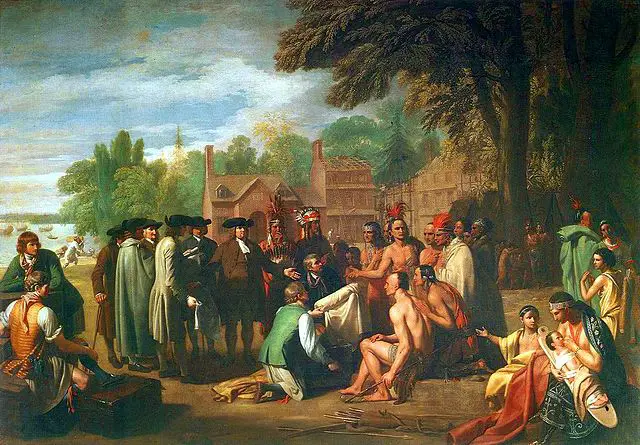Native American Conflicts
Native Americans or Native Indians that resided in the New World had different ideas of life and religion than the English invaders.
While Native Indians believed that no one owned land and that one should only take what is needed to live, the English colonists believed and acted in the opposite.
The additional belief by the English that Native Indians were barbarians just added to the tension between the settlers and the Native Indians.
The English, Dutch, and Spanish invaders of North America brought with them the idea that they were superior to the Native residents, and they claimed the land for each of their countries. Native Indians had lived on these lands for thousands of years and had hundreds of different tribes.

- As the Europeans continued to try to expand and take the land, a variety of wars and attacks happened called the American-Indian Wars. Most of the wars were over the control of the land.
- The Jamestown Massacre happened on March 22, 1622, when the Powhatan Indians attacked the settlement of Jamestown. This attack killed many of the settlers, and the British Crown decided to attack the Indians in retaliation and take their land.
- The Pequot War happened in 1636 and was caused by a trade expansion conflict. Some of the colonies had Native Indian allies that joined them in battling and defeating the Pequot.
- As the British continued to expand and take over areas where Native Indians lived and hunted, more battles happened. Between 1636 and 1659, the settlers from the New Netherlands in New York and the Indian tribes of the Algonquians, Susequannocks, Esopus, and Lenape fought with the settlers. Some fights were so brutal that the settlers returned to the Netherlands.
- Some Indian tribes aligned with the French to fight against then huge Iroquois Confederacy. Between 1640 and 1701, the Beaver Wars were fierce battles involving the control of the fur trade and territories in the Great Lakes regions. The War ended with the Great Peace Treaty.
- The Metacom’s War is also called King Philip’s War and happened from 1675-1676. It started when a group of Native Indians, led by Wampanoag Chief Metacom, attacked colonies, settlements, and the militia all through Rhode Island and Massachusetts. They were angry at the fact that their lives were becoming dependent upon the Puritans. The Chief was later referred to as “King Philip,” and these attacks started a series of fighting that ended with the deaths of almost all of the Native Indians that were involved in his group.
- From 1702 through 1713, Queen Anne’s War happened between English and French colonists and the Native Indians that stood with each group. The fighting happened in New England, Acadia, Newfoundland, and Spanish Florida. Although it finally ended with the Treaty of Utrecht, the Native Indians were not included in the peace talks, and this resulted in them losing a lot of their land.
- Treaty disputes also caused battles, and from 1711 through 1715, the Tuscarora War involved Native Indians burning own many of the settlements in North Carolina and killing the colonists. The War ended with the help of South Carolina, defeating the Native Indians. The loss of their land, combined with being indebted to the colonists caused Native Indians to form a confederacy with other tribes. Many in South Carolina were afraid and left, and this destroyed the colony’s economy.
- From 1754 through 1763, the French were continuing to expand into the Ohio River Valley, and the expansion created fights with the British that were already in control. Both the British and the French gained Native Indians tribes to fight on their respective sides, and the battles were called the French and Indian War. The War ended with all parties signing the Treaty of Paris in 1763.
- The Ohio River Pontiac Indians became angry in 1763 when they found out that King George II of England required them to become British loyalists. The War that broke out is called Pontiac’s War and was led by the Ottawa Chief Pontiac and the other tribes that supported him. They attacked Britain’s Fort Detroit. When these Native tribes found out that the British were going to attack them back, they killed many British soldiers on July 31stin what is called the Battle of Bloody Run.
- On August 20, 1794, the Battle of Fallen Timbers happened between the by then, well trained U.S. Army and three of the Native Indian tribes: Shawnee, Miami, and Lenape. The fighting ended with the Treaty of Greenville.
- The Cherokee Wars are some of the most well-known and happened in 1759 in areas from North Carolina, Virginia, and further south. The fighting ended only when the Cherokee were forced to give up millions of acres of land to the settlers. This decision created a situation where the Cherokee later fought on the side of the British during the Revolutionary War.
- As colonists continued to arrive and expand into North America, more and more land was taken, and the Native Indians were pushed and forced into areas that were often considered to be uninhabitable.
Q&A:
What was the common reason for almost all of the Indian wars?
Colonists taking Native Indian lands
Why did the Ohio River Pontiac Indians become angry in 1763 at King George II of England?
he wanted the Indians to become British loyalists
What did the Cherokee nation have to give up at the end of the Cherokee Wars?
millions of acres that they lived in
What were two of the main differences in belief between the colonists and Native Indians that caused wars?
land ownership and the colonists thought the Native Indians were barbarians
What three European groups were responsible for most of the settlements in North America?
English, Dutch, and Spanish
Which Indian colonist war ended with the collapse of a colony economy?
Tuscarora War



